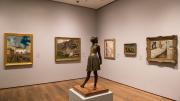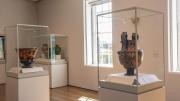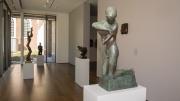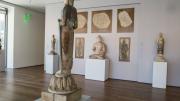For what she called “the launch of the launch” of the expanded Harvard Art Museums in November, President Drew Faust invited the campus community to the Northwest Building on Thursday evening for a panel discussion on “Art Museums and the University: A New Paradigm.” During the long period of renovation—“six years in which it was entirely closed, and a much longer period of time of re-planning and reimagining”—Faust said that, “in some ways, we've forgotten what it’s like to be a university with a museum.” Taking place in the weeks anticipating the doors’ reopening, the discussion would reflect on such fundamental questions as “What is a museum for?” and “What, indeed, is a museum?”
Moderated by Thomas W. Lentz, Cabot director of the Harvard Art Museums, the panel included Paul C. Ha, director of MIT’s contemporary art museum, Glenn D. Lowry, Ph.D. ’82, director of the Museum of Modern Art since 1995, and Jennifer L. Roberts, art historian and Agassiz professor of the humanities. Together, they brought their collective expertise in curatorial work, museum direction, fundraising campaigns, teaching, and academia to the task of examining the museum experience within a campus setting.
Lentz opened by asking the panelists to explain why they thought museums were important on campus, which he called “an alpha-numeric environment” harboring the notion that visual arts were “extracurricular” and museums themselves a “luxury.” The panelists seemed to agree that such a notion was outdated. “The new generation expects a teaching university to have a museum, just like they expect a library, just like they expect a sports complex,” Ha said. If a tour guide tells a prospective student or parent that there is no museum, he added, they might ask, “Why don’t we go to Yale?” Beyond the confines of the Ivy League, he explained, institutions including Seattle University, the University of Chicago, and Colby College were opening museums.
Roberts answered that she saw “luxury” as a “serious” and “even dangerous” term to apply to art museums. “Art is a form of intelligence,” she said, and an art object itself was a form of technology—a nonverbal embodiment of material, historical, and spatial intelligence that “students can learn a great deal from.” The co-creator of the humanities course, “Frameworks: The Art of Looking,” Roberts emphasized how in-person encounters with art, in a museum setting, could inculcate students with a habit of thoughtful, meditative attention (see “The Power of Patience,” November-December 2013, page 40). Developing this ability to think about and through images, she added, was even more essential to students in the digital age.
During the hour, the discussion expanded upon the issue of how museums might adapt to that digital age. The recurring question of whether photography within galleries should be encouraged or discouraged, Lowry pointed out, was a flashpoint in a larger negotiation over the museum’s potential to be both a “dynamic social space,” fostering conversations and active learning, and a sanctuary for contemplation. This led to further talk about the relationships between the digital and physical realms. “The digital is the friend of the analog,” said Lowry. “They're inherently woven into each other's existence at this point, and the trick is, how do you use the availability of digital imagery to trigger an even greater desire to come experience and explore the real object?”
The half-hour devoted to questions from the audience largely concerned such issues as how a museum’s vision interacts with those of various stakeholders—whether members of a governing board, academics collaborating with curators, or teachers who wanted to host discussions about art beyond the classroom or slide-lecture format.
One question, however, raised the possibility of another constituency: the larger public. “What is the role of the university museum in the community beyond the walls of the institution?” the audience member asked. In reply, Ha spoke about what he saw as a change in the “culture of museums” paralleling similar debates in the opera and theater worlds. Leaders in the arts were “catching up with the times” by asking themselves, “How do we matter to our public?”
For his part, Lentz called it “a challenging question on many levels.” His response focused on the museums’ new physical identity, and on architectural improvements as a metaphor for openness. During the planning stages, he reported, the museums’ administrators had participated in many discussions with outside organizations such as the Cambridge Historic Commission, as well as with their curatorial staffs, seeking to balance the parties’ sometimes competing concerns about allocating space to functions beyond exhibition. Administrators didn’t want to create “a static treasure house” or “academic bunker,” said Lentz; a commitment to a friendly and welcoming atmosphere would require visitor amenities.
“In our new facility, we actually have another entrance that lines up with our old historic entrance,” he added. “It’s actually bigger, it’s more welcoming, it’s more transparent.” It will enable the art museums complex to function like the Smith Campus Center, he explained, so that people may move through the entrances and exits of the building, or gather in the courtyard, without entering the galleries. (Unlike peer institutions such as Yale and Princeton, Harvard charges the general public admission to its museum galleries in most cases.)
With the Harvard Art Museums’ public opening on November 16, the evening’s discussion offered a taste of the broader, lively commentary that the new building might encourage: about how to define art and its audience, and how to shape the space between them.











